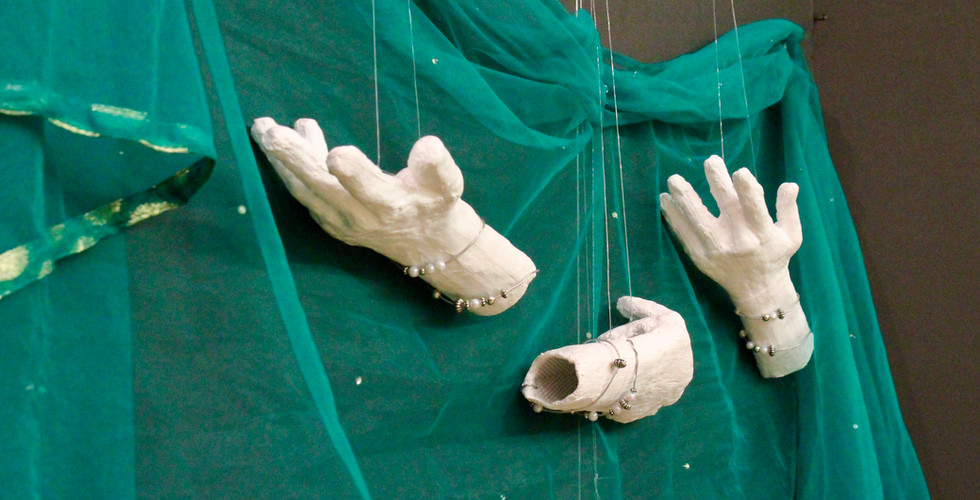Vernissage Review
- Nicole Dirks
- Jun 12, 2019
- 4 min read
This year, before attending Vernissage, TFS’s student art show, I took it upon myself finally to look up the historical significance of the show’s title after 6 years of viewing the exhibition. I discovered that vernissage denotes a private viewing of an exhibition, a meaning that has grown out of the French word’s literal meaning -- varnishing. In the 19th century, the day before an exhibition would open to the public, artists used to varnish their paintings to seal their completion, a ceremony often informally attended by friends.
TFS’s version is a little different --- our varnishing day is not the minor precedent to the ‘big reveal,’ but rather the main event. However, the show maintains the personal nature of the original Vernissage. Our connections to the artists add another layer to our appreciation of the pieces that we don’t often feel at typical exhibitions. Notably, this familiarity adds an air of veneration and understanding toward students’ work from parents, teachers, students and other visitors that can be felt while touring the exhibition. We’ve had glimpses at pieces over two year and we know the students’ interests or, at the very least, we know they are TFS students-- which is more than we normally know at art exhibits.

During an initial survey of the exhibit, I was immediately drawn to Layal Farah’s collection titled “Dreams vs Reality,” specifically her piece inspired by Vermeer’s “Girl With a Pearl Earring” (except without the pearl earring). Struck by sense of liberation in Layal’s piece a
bout the already-mysterious girl from Vermeer’s painting, I was not surprised to learn that Layal sought to explore “finding the magic in our everyday lives by taking ordinary occurrences and lifting them into the surreal” in her exhibit. The metallic detail, which best establishes the otherworldliness of the piece, was not planned. “Initially, I had intended to only paint the girl. When Ms. Markovic [the visual arts teacher] found the metallic paper, I ended up cutting out the subject and moving it onto a black backdrop with the added metallic accents.”
Inspired by Gabriel Garcia Marquez’s Chronicle of a Death Foretold, a novel studied in the Level V English literature class, animator Hayao Miyazaki,famous for films like “Spirited Away” and “Totoro,” as well as philosophers who question how whether we can be certain of our reality, “Dreams vs Reality” vividly utilizes light and motion to meld familiar elements with magic. We are invited to both see the wonder in our reality and escape it; we appreciate the practicality of impracticality.
In contrast with the escapism of Layal’s exhibit, Yasmine Lecomte tackles bringing us back to everyday reality to reflect on pressing social issues. Titled “Hands of Change,” the exhibition uses the motif of hands to unite several themes: our role in climate change, our growing lack of individuality due to social media and wars as conflicts of beliefs, specifically war in the Middle East. The hands broadly take on the symbolism of human action, but, in different pieces, difference qualities are associated with them. In “pollution,” the intensive use of lines in the hands’ shading implies experience, in turn suggesting that ageing populations’ continual negligence in failing to change their environmentally destructive habits and our long-term impact as a species on the whole.
In “war,” the positioning of hands like in Michelangelo’s "The Creation of Adam” adds a dimension of complexity to an evident critique of the avoidable slippery slope of human bloodshed in conflict. In Michelangelo’s piece, God is reaching out as far as he can to touch Adam, who seems to be barely lifting his finger to make contact with God, thus inviting us to reflect on attainability of a connection with God, or our hopes, if we simply make a conscious effort to reach out. In the context of Yasmine’s piece, we question: if one of the hands is God’s, and not another human’s, what does that suggest about the role of religion in war? If we only make a superficial connection to a higher being, then engage in war to defend our connection, does that mean we are not truly following our faith? Or, if God and man made a full connection, would the bloodshed be even worse? Or is our connection to God/a god never quite attained due to our tendency to engage in war, explaining a misguided, incomplete effort to connect to God? It is this ambiguity that is most powerful about Yasmine’s work.

A close-up of the sound sculpture made by Kamiyu Hanada
TFS was one of 5 I.B. schools in the world to be selected to produce a sound sculpture this year. Kamiyu Hanada created an inviting piece that let you swim in its whimsy. Suspended in a circle, consisting of juxtaposed beaded threads with bells at the bottom, the sculpture was highly interactive. This quality made it a hub for children, students and adults who passed their hands through the threads to listen to the cascade of chimes produced.
This year’s exhibitions were both varnished and raw; perfectly planned and improvised; gratifying and dreamy. With artists, discovering their work, I felt at once more familiar with them, yet also like I never really knew them-- all in true TFS Vernissage fashion.























Comments